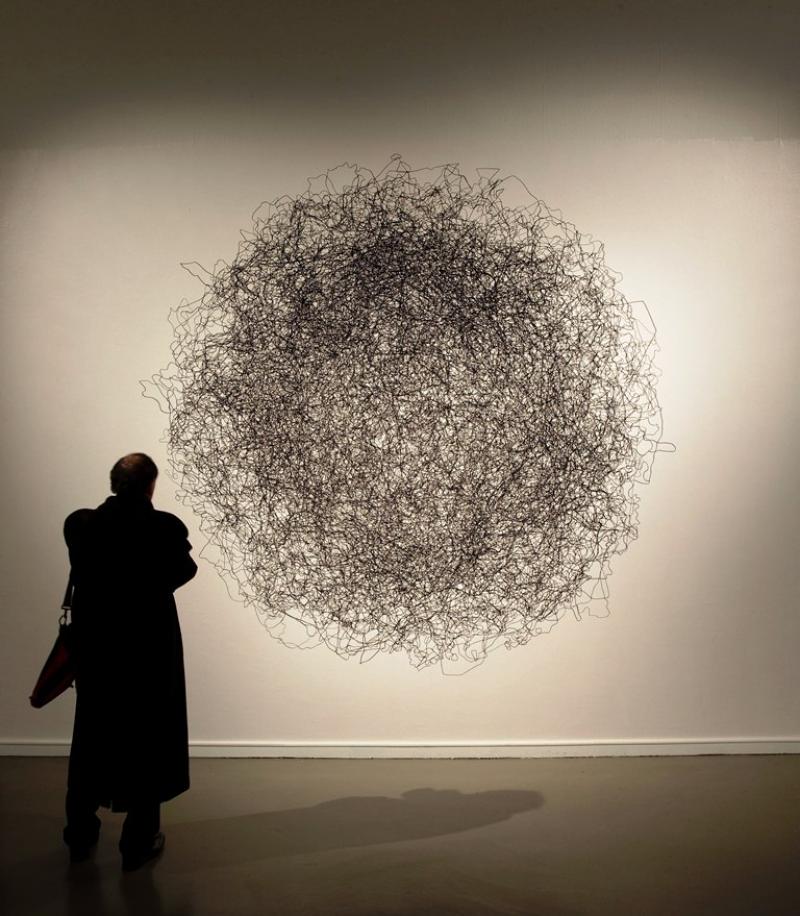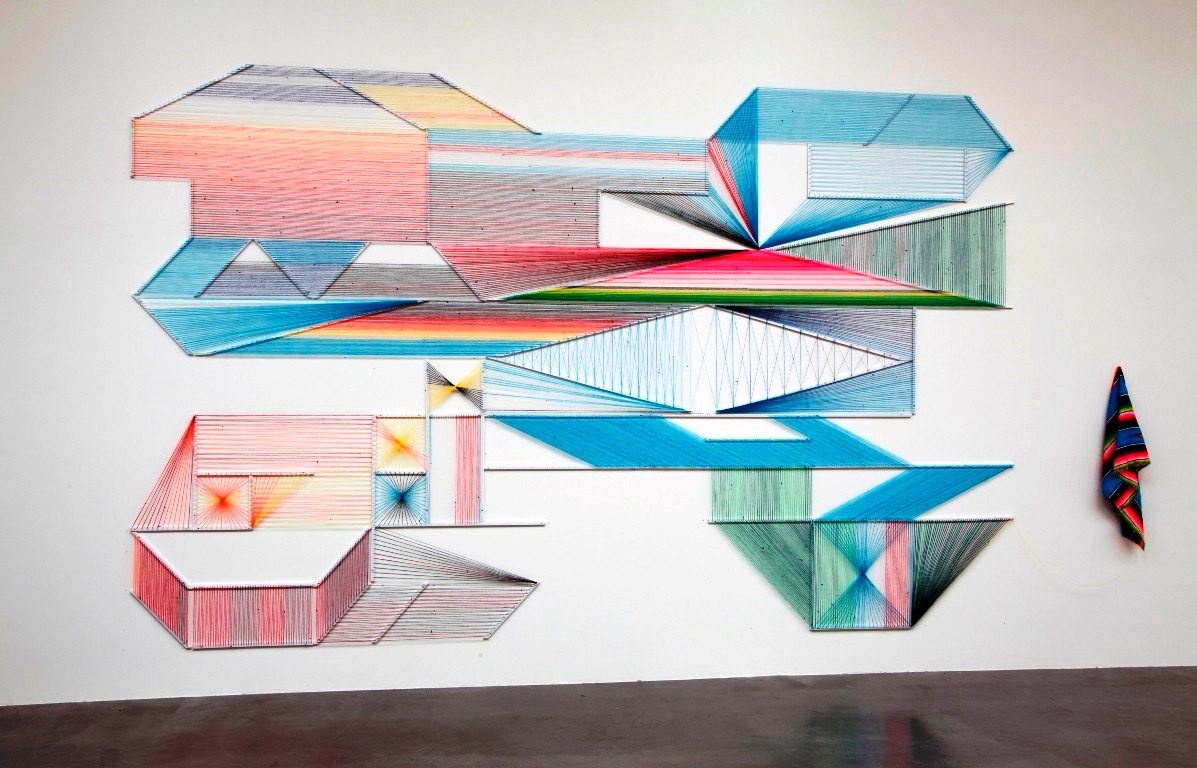Lines of Thought, Parasol Unit | reviews, news & interviews
Lines of Thought, Parasol Unit
Lines of Thought, Parasol Unit
Lines go for walks. And runs. And skips, frolics and meanders

A show about lines: my tiny minimalist heart goes pitter-patter. And with good cause. Lines can be a bit blah – a quick scribble, and you’re on to the next thing. But they can also by their very simplicity, their irreduceability, lay bare some fundamentals, can draw a line under (yes, lots of “line” jokes available: line right up!) what really matters.
 Two of the artists at the core of minimalism set the tone. Sol LeWitt produced instructions for wall drawings of lines which were invariably minutely detailed, yet also magically permitted great freedom for the person actually “transcribing” his instructions onto the wall, so that no two renditions of any drawing were the same. Here Wall Drawing #103: Not straight vertical lines from floor to ceiling, using as much wall area as is determined by the drafter is a delicate, tenuous rendering, gently drifting across the wall.
Two of the artists at the core of minimalism set the tone. Sol LeWitt produced instructions for wall drawings of lines which were invariably minutely detailed, yet also magically permitted great freedom for the person actually “transcribing” his instructions onto the wall, so that no two renditions of any drawing were the same. Here Wall Drawing #103: Not straight vertical lines from floor to ceiling, using as much wall area as is determined by the drafter is a delicate, tenuous rendering, gently drifting across the wall.
Across the room is a fabulous yellow steel piece by Fred Sandback, Untitled (Nr. 4) (right), a four-part piece of rods shaped at right angles that somehow fuse the right angle of the wall and floor, to create a square where previously none was visible. Sandback’s pieces are magic: thin, recessive, yet no one is ever willing to walk “through” one, so robust is the idea the sculptor has created in the viewer’s mind.
James Bishop, too, worked with line, although his were created in oil, building the illusion of line out of layers of almost-but-not-quite identical colour-waves. The poet John Ashbery called his oil and crayon works on paper “part air, part architecture”, and I can think of no better way to describe these softly shifting shapes: houses for invisible children, perhaps.
 The show is not reductive, however, and it demonstrates how lines can be far more than a trace of graphite on paper, or steel in the air. Richard Long, whose art circles around walking, and the marking off of his walks in nature or on paper or in signs and symbols, has three pieces here, none of which is directly linear, but all of which explore what lines might encompass. Red Slate Circle seems at first flatly to contradict the notion of linearity, but both the slate itself – its small fissures and “lines” becoming obvious as one looks – and notions of how Long goes about finding his material make clear that his work is less about what we see on the gallery floor, and more about a body moving through space in a line, with the slate, or the wall marks, or the diary notations that make up Long’s art a reference point, rather than the work itself.
The show is not reductive, however, and it demonstrates how lines can be far more than a trace of graphite on paper, or steel in the air. Richard Long, whose art circles around walking, and the marking off of his walks in nature or on paper or in signs and symbols, has three pieces here, none of which is directly linear, but all of which explore what lines might encompass. Red Slate Circle seems at first flatly to contradict the notion of linearity, but both the slate itself – its small fissures and “lines” becoming obvious as one looks – and notions of how Long goes about finding his material make clear that his work is less about what we see on the gallery floor, and more about a body moving through space in a line, with the slate, or the wall marks, or the diary notations that make up Long’s art a reference point, rather than the work itself.
Geographical “lines” appear in other works, too: Jorge Macchi’s charmingly quirky Horizonte (above), a small photograph of a horizon at sea, with, either side of that line of horizon, springs that continue and exaggerate the endlessly receding line; or, more imposingly, Adrian Esparza’s Here and Now (below), where a small Mexican serape hangs on the gallery wall, with one small thread pulled out from the tight weave, leading astonishingly to a vast wall-piece made up of similar coloured threads, an MC Escher of Central American colour; or Hemali Bhuta’s wax lines of candles, clustered by the gallery ceiling in a womb-like enclosure of burnt-out stalactites.
 In keeping with their minimalist forebears, most of the pieces are resolutely abstract: they say whatever the viewer wants to read into them. But Ceaseless Doodle, by Özlem Günyol and Mustafa Kunt, has both an immediate impact, this huge wall drawing in marker pen initially appearing ambivalent from a distance – is it a drawing, or a metal sculpture? – and a more conceptual layer. Taking every country in turn, the artists have reduced each one to a single-sized format, drawn its outline and then projected all of them simultaneously onto the wall, to create what looks like a cat’s-toy ball of wool, but is, in reality, our messy, complex world.
In keeping with their minimalist forebears, most of the pieces are resolutely abstract: they say whatever the viewer wants to read into them. But Ceaseless Doodle, by Özlem Günyol and Mustafa Kunt, has both an immediate impact, this huge wall drawing in marker pen initially appearing ambivalent from a distance – is it a drawing, or a metal sculpture? – and a more conceptual layer. Taking every country in turn, the artists have reduced each one to a single-sized format, drawn its outline and then projected all of them simultaneously onto the wall, to create what looks like a cat’s-toy ball of wool, but is, in reality, our messy, complex world.
Paul Klee famously said that drawing was simply taking a line out for a walk. In Lines of Thought, lines go for walks. And runs. And skips, frolics and meanders. It is a pleasure to be able to accompany them.
rating
Buy
Explore topics
Share this article
The future of Arts Journalism
You can stop theartsdesk.com closing!
We urgently need financing to survive. Our fundraising drive has thus far raised £33,000 but we need to reach £100,000 or we will be forced to close. Please contribute here: https://gofund.me/c3f6033d
And if you can forward this information to anyone who might assist, we’d be grateful.

Subscribe to theartsdesk.com
Thank you for continuing to read our work on theartsdesk.com. For unlimited access to every article in its entirety, including our archive of more than 15,000 pieces, we're asking for £5 per month or £40 per year. We feel it's a very good deal, and hope you do too.
To take a subscription now simply click here.
And if you're looking for that extra gift for a friend or family member, why not treat them to a theartsdesk.com gift subscription?
more Visual arts
 Help to give theartsdesk a future!
Support our GoFundMe appeal
Help to give theartsdesk a future!
Support our GoFundMe appeal
 Bogancloch review - every frame a work of art
Living off grid might be the meaning of happiness
Bogancloch review - every frame a work of art
Living off grid might be the meaning of happiness
 Do Ho Suh: Walk the House, Tate Modern review - memories are made of this
Home sweet home preserved as exquisite replicas
Do Ho Suh: Walk the House, Tate Modern review - memories are made of this
Home sweet home preserved as exquisite replicas
 Ed Atkins, Tate Britain review - hiding behind computer generated doppelgängers
Emotions too raw to explore
Ed Atkins, Tate Britain review - hiding behind computer generated doppelgängers
Emotions too raw to explore
 Echoes: Stone Circles, Community and Heritage, Stonehenge Visitor Centre review - young photographers explore ancient resonances
The ancient monument opens its first exhibition of new photography
Echoes: Stone Circles, Community and Heritage, Stonehenge Visitor Centre review - young photographers explore ancient resonances
The ancient monument opens its first exhibition of new photography
 Hylozoic/Desires: Salt Cosmologies, Somerset House and The Hedge of Halomancy, Tate Britain review - the power of white powder
A strong message diluted by space and time
Hylozoic/Desires: Salt Cosmologies, Somerset House and The Hedge of Halomancy, Tate Britain review - the power of white powder
A strong message diluted by space and time
 Mickalene Thomas, All About Love, Hayward Gallery review - all that glitters
The shock of the glue: rhinestones to the ready
Mickalene Thomas, All About Love, Hayward Gallery review - all that glitters
The shock of the glue: rhinestones to the ready
 Interview: Polar photographer Sebastian Copeland talks about the dramatic changes in the Arctic
An ominous shift has come with dark patches appearing on the Greenland ice sheet
Interview: Polar photographer Sebastian Copeland talks about the dramatic changes in the Arctic
An ominous shift has come with dark patches appearing on the Greenland ice sheet
 Donald Rodney: Visceral Canker, Whitechapel Gallery review - absence made powerfully present
Illness as a drive to creativity
Donald Rodney: Visceral Canker, Whitechapel Gallery review - absence made powerfully present
Illness as a drive to creativity
 Noah Davis, Barbican review - the ordinary made strangely compelling
A voice from the margins
Noah Davis, Barbican review - the ordinary made strangely compelling
A voice from the margins
 Best of 2024: Visual Arts
A great year for women artists
Best of 2024: Visual Arts
A great year for women artists

Add comment